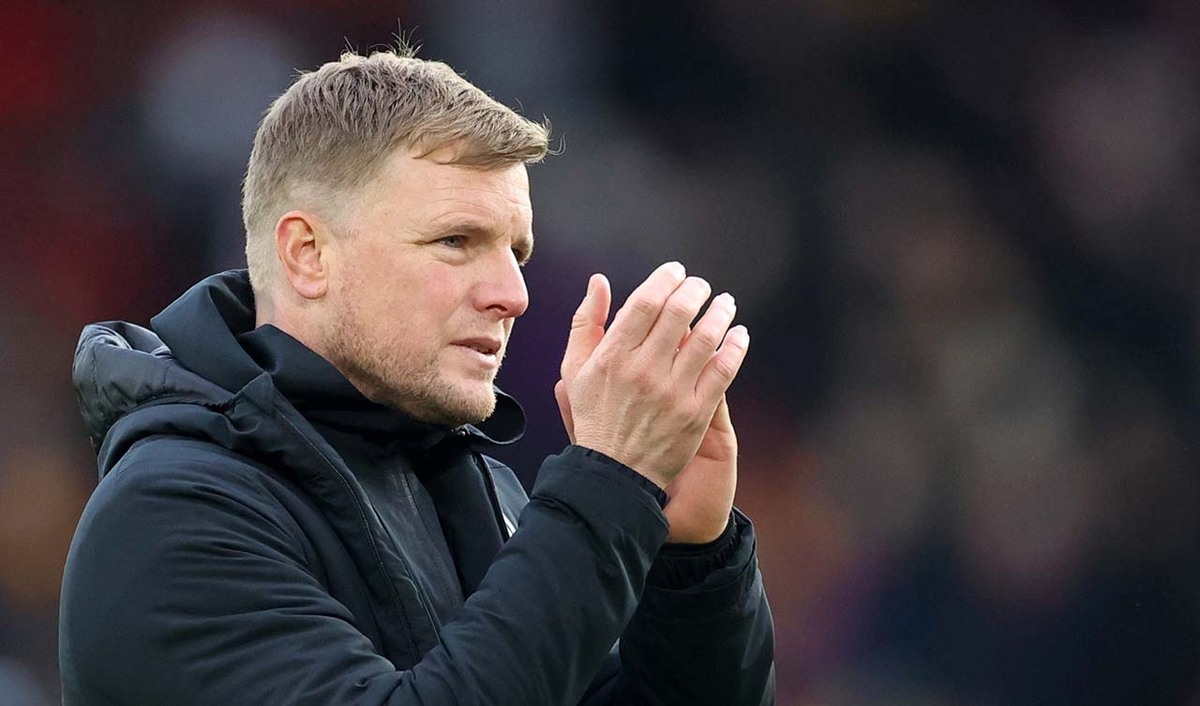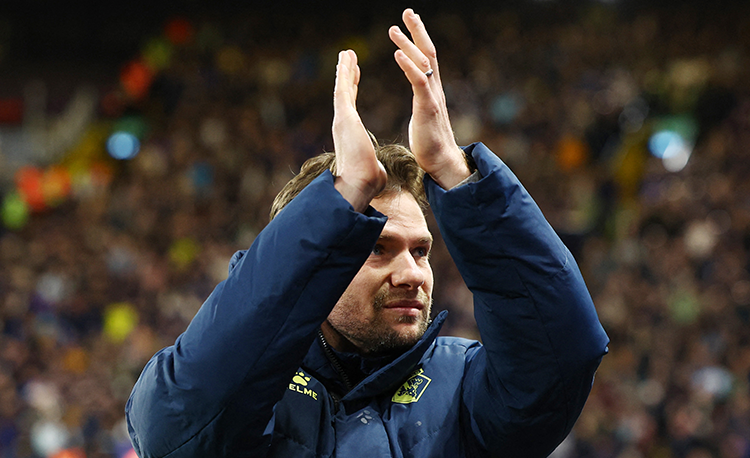You are viewing 1 of your 1 free articles
Breaking lines
Getting players comfortable when both in and out of possession has been central to my coaching philosophy. I have seen players making huge strides in what they do when mastering the art of protecting or pursuing the ball, and good possession habits ultimately translate on the pitch into other skills.
| Area | Up to 36x20 yards |
| Equipment | Balls, bibs, flat cones, goals, discs |
| No. of Players | Up to 11v11 |
| Session Time | 60mins |
Getting players comfortable when both in and out of possession has been central to my coaching philosophy. I have seen players making huge strides in what they do when mastering the art of protecting or pursuing the ball, and good possession habits ultimately translate on the pitch into other skills, so I regard this session as a base onto which further development of players can be built.
RONDO
What do I get the players to do?
The functional midfielder
Setting up as shown (1a) in the centre circle, the ball always starts with the coach, who feeds in, with the players on the outside looking to keep the ball away from those in the middle. They do this by using short passes to lure the defenders in, then penetrating between by playing long between the lines. These players on the outside of the circle are always moving ready to receive.
If the team in possession reaches 25 passes, the possession pauses and a round of applause sounds for the achievement. Play then restarts quickly.
1a
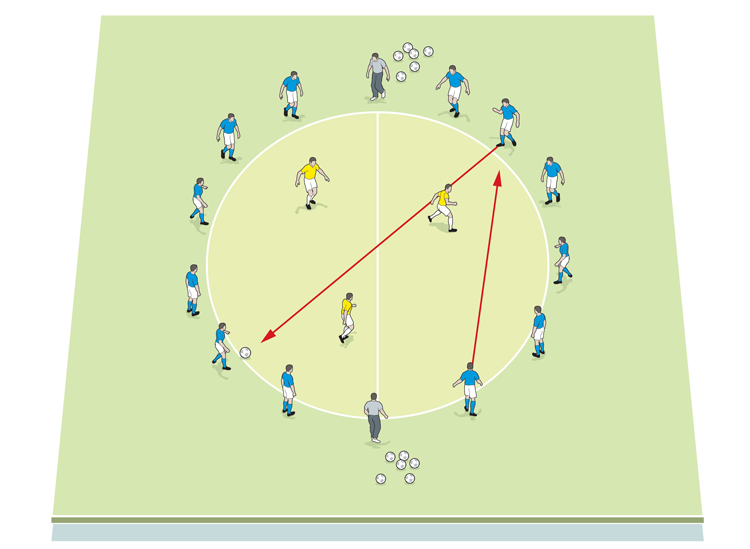
What are the key things to look out for?
When in possession players must keep the ball by using a good weight of pass and touch. They need to show awareness of what’s around them, adopting good body positions as they do so.
Out of possession the reaction must be to press. Team mates need to work together in closing down both space and opponents.
When one of the three defenders wins back possession in the middle of the circle, it must be a clear win and not just a touch. That defender team must be in control of the ball, or he can kick out of the circle. Now players switch, so the drill will be restarted with the man who conceded possession ‘reaction pressing’, with the players on his left and right side reacting to join him.
How do I progress the practice?
For the first progression we add an extra body in the middle (so four closers), with outside men restricted to one or two touches (1b). When the ball breaks down the man who conceded possession transitions quickly into the circle, with those on the left and the right joining him. The coach will call one of the three coming out of the drill to make the fourth.
1b

As a further progression we can add a floater to the middle for one-twos and bounce passes.
FIVE-BOX PENETRATION
What do I get the players to do?
In this challenge the objective is to develop quick combination play with a focus on passing forward through the lines. So setting up in a 36x20-yard area we mark out six 6x20-yard zones. We work with two keepers and five teams of four. Three of the teams represent attackers in zones 1, 3 and 5, while two operate as defenders in zones 2 and 4. All players must stay in their zones (2).
The game starts with the coach who plays to the keeper, who then feeds into zone 1. The objective is to play forward and through the lines, across the four zones to end with the keeper at the opposite end. This is a continuous end-to-end timed practice.
If the defending teams in either zones 2 or 4 block any through pass, the team of four conceding possession swaps zones. The defending team now becomes the attacking team.
The attacking team can move the ball at speed across the four to work the opening to penetrate, and can penetrate ‘in one’ when receiving from the keeper if they can work the opening, or if the defending team are unbalanced. If the attacking team is slow, at the coach’s discretion he can switch them with a defending team.
2

What are the key things to look out for?
Defending teams need to work together in compact units as well as being quick to shuffle across their respective zones.
And when teams change from attack to defence or defence to attack, transitions must be quick so that an instant reaction (from both sides) can be seen.
When in possession, it’s two-touch maximum per player. We want to see a real speed to the practice and good body shape. We also demand good awareness of the ball, of team mates and opponents, smart decision-making and a measured weight of pass.
Out of possession we’re looking for good communication with team mates being a sensible distance apart. Players must also know to shuffle across the area.
SMALL-SIDED GAMES
What do I get the players to do?
In this challenge the objective is to penetrate lines to a 3v2 counter-attack.
Resting greens start with the ball and will play to any one of the yellows. Yellows can penetrate if one of the defending four is disorganised, or work a clever opening between their opponents (3a).
The defending four will have to work together to stop the penetrating pass – that means moving their feet and shuffling quickly to make sure distances and positioning are compact.
When the blues are penetrated they have to make a recovery run which transforms the practice into a 6v3 in the defending team’s favour.
3a
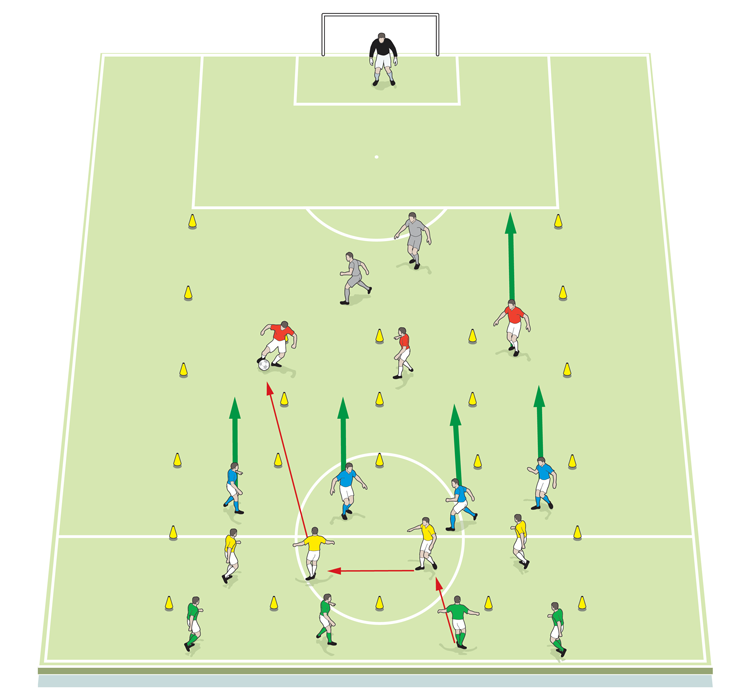
When the pass is penetrated to the reds it creates a 3v2 situation. The reds attack quickly at pace avoiding back tackles from recovering back defenders. The attacking three look for overlaps and clever interplay around the box (3b).
3b

If the defending team wins the ball back they have an ‘out pass’ in the form of the resting two defenders, and this ends the drill.
We will keep players moving between challenges regularly, with defenders rotating positions with each other. Greens, yellows, blues and reds move up a zone - for example greens go to the yellow zone, yellows go to the blue zone and become defenders, while blues become the reds for the 3v2, with one man resting. Reds rotate to start and become greens.
When in possession we want players to move the ball quickly to work the opening to penetrate. Body shape for passing forwards and receiving in pockets is crucial, as is good awareness and dribbling, overlaps, decision-making and the ability for players to capitalise on goalscoring opportunities.
When out of possession we want players to shuffle, slide, block and make recovery runs. Defenders in a 3v2 must be slow coming away from goal, aiming to slow the attack for the recovering four.
PLAYING THROUGH THE THIRDS
What do I get the players to do?
The functional striker
Setting up as shown this is an 11v11, working box-to-box, seven steps in from the touch line. Reds set up 1-4-2-3-1 while blues are 1-4-3-3.
The objective is to play through the thirds, with players free to play in all zones with the only restrictions being on touches. So in zone 1 the restriction for the team in possession is that it is two touches. Zone 2 also has a two-touch restriction whereas zone 3 is all in.
The team in possession always starts the drill from the keeper, with a concentration on quick play, making the pitch big and looking to score.
The team out of possession must work the line, press high and look to win the ball high up the pitch. If the press is pierced, they must recover their shape as quickly as possible. The other focus should be on the block, playing with compactness and getting ready with a reaction press.
If the defending team wins back possession, the roles reverse. The touch restrictions stay the same in the zones - the attacking team become defenders.
Offsides apply while keepers have four seconds to get the ball back into play if it comes back to them from a corner or throw-in.
4
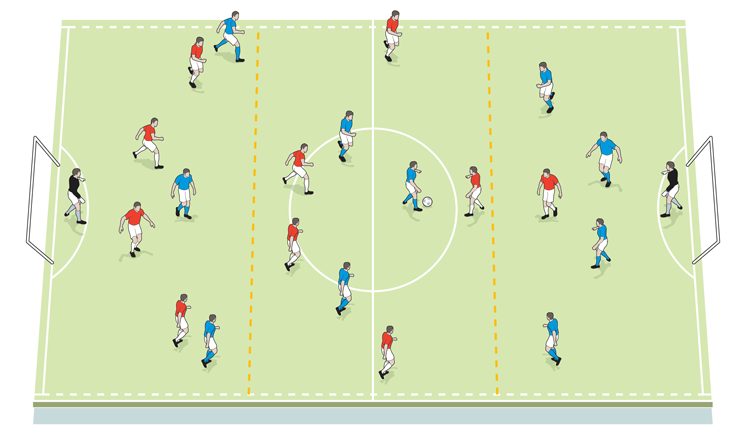
How do I progress the practice?
To progress we can change touch restrictions in each zone. Furthermore, we can put balls around the outsides enabling quick throw-ins, and can look at adding a floater. Finally, we might condition the practice so the ball cannot be played back once the ball moves into the next zone.
Related Files
Editor's Picks
Deep runs in the final third
Using the goalkeeper in build-up play
Pressing principles
Intensive boxes drill with goals
Penetrating the final third
Creating and finishing
My philosophy
Pressing initiation
Compact team movement
Coaches' Testimonials

Alan Pardew

Arsène Wenger

Brendan Rodgers

Carlos Carvalhal

José Mourinho

Jürgen Klopp

Pep Guardiola

Roy Hodgson

Sir Alex Ferguson

Steven Gerrard
Coaches' Testimonials

Gerald Kearney, Downtown Las Vegas Soccer Club

Paul Butler, Florida, USA

Rick Shields, Springboro, USA

Tony Green, Pierrefonds Titans, Quebec, Canada
Join the world's leading coaches and managers and discover for yourself one of the best kept secrets in coaching. No other training tool on the planet is written or read by the calibre of names you’ll find in Elite Soccer.
In a recent survey 92% of subscribers said Elite Soccer makes them more confident, 89% said it makes them a more effective coach and 91% said it makes them more inspired.
Get Monthly Inspiration
All the latest techniques and approaches
Since 2010 Elite Soccer has given subscribers exclusive insight into the training ground practices of the world’s best coaches. Published in partnership with the League Managers Association we have unparalleled access to the leading lights in the English leagues, as well as a host of international managers.
Elite Soccer exclusively features sessions written by the coaches themselves. There are no observed sessions and no sessions “in the style of”, just first-hand advice delivered direct to you from the coach.
